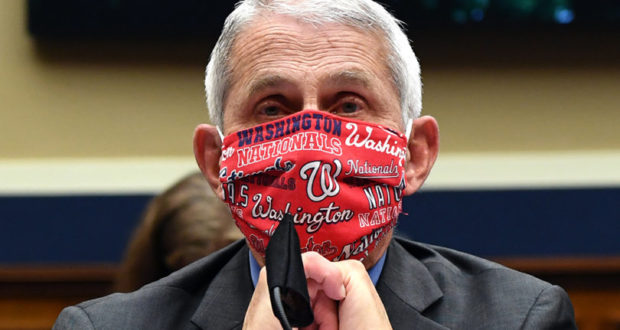إيان ميلر – أصبحت الأقنعة نقطة وميض سياسية وثقافية ، مما أدى إلى ظهور معلومات غير دقيقة لا نهاية لها من وسائل الإعلام ، ويرجع الفضل في ذلك بشكل أساسي إلى نصيحة الدكتور فوسي التي لا أساس لها من الصحة والتي تفيد بأنها كانت مفيدة في منع انتشار COVID-19.
في 4 فبراير 2020 ، قبل شهر واحد فقط من مقابلته 60 دقيقة ، وقبل شهرين من تغيير مركز السيطرة على الأمراض – بدعم من Fauci – توجيه قناعهم ، تلقى بريدًا إلكترونيًا من سيلفيا بورويل ، التي عملت سابقًا كوزيرة للصحة والإنسان الخدمات في عهد الرئيس أوباما.
سأل بورويل Fauci عما إذا كان يجب عليها إحضار قناع معها أثناء السفر ، فأجاب: “الأقنعة حقًا للأشخاص المصابين لمنعهم من نشر العدوى إلى الأشخاص غير المصابين ، بدلاً من حماية الأشخاص غير المصابين من الإصابة”.
والأهم من ذلك ، أنه قدم لها أحد الأسباب العديدة القائمة على العلم لعدم ضرورة ذلك ، “القناع النموذجي الذي تشتريه من الصيدلية ليس فعالًا حقًا في إبعاد الفيروس ، وهو صغير بما يكفي لتمرير المواد. ومع ذلك ، قد يوفر بعض الفوائد الطفيفة في الاحتفاظ [] بالقطرات الإجمالية إذا كان شخص ما يسعل أو يعطس عليك. لا أوصي بارتداء قناع … “
هناك العديد من النقاط الرئيسية التي يجب تسليط الضوء عليها حول رده ، بدءًا من تصريحه بأن الأقنعة لا تهدف إلى توفير الحماية لمن يرتديها.
على الرغم من أن هذا يتفق مع التوصية الأولية للجمهور بارتداء الأقنعة كشكل من أشكال “التحكم في المصدر” ، أكد مركز السيطرة على الأمراض و Fauci أن الانتشار بدون أعراض كان السبب في التوصية بإخفاء شامل. ولكن كما لوحظ سابقًا ، فإن الانتشار بدون أعراض نادر جدًا إلى غير موجود.
إذا كان الأفراد الذين تظهر عليهم الأعراض أو أولئك الذين في المراحل المبكرة جدًا من ظهور الأعراض هم المسؤولون عن الغالبية العظمى من انتشار المرض ، كما تشير دراسات متعددة ، فإن الأقنعة لن تكون فعالة أبدًا في منع الحالات التي لا تظهر عليها أعراض من الانتشار إلى الآخرين. التوصيات الجديدة محكوم عليها بالفشل بمجرد تنفيذها.
ثانيًا ، وعلى وجه الخصوص ، قدم Fauci شرحًا محددًا للعيوب الكامنة في الأقنعة التي اشتراها عامة الناس: أن الفيروس صغير جدًا ويمر عبر المادة. توضح هذه الجملة وحدها التناقض الذي لا مفر منه في بيانه الأخير بشأن نقص الإمداد باعتباره تردده الأولي في التوصية بالأقنعة. كان رده الفوري ، الذي يُفترض أنه يستند إلى الأدلة العلمية التي شاهدها وراجعها ، أن الأقنعة لا تعمل ضد الفيروسات.
إن تأكيده على أن الأقنعة قد توفر بعض الفوائد الطفيفة ضد القطرات التي يسببها السعال والعطس هي بالضبط نفس الحجة التي يستخدمها مركز السيطرة على الأمراض والآخرون لتبرير الإخفاء ، لكن بيانه السابق ينفي هذا الخط من التفكير تمامًا.
إذا أوقفت الأقنعة بعض القطرات ولكن الفيروس صغير جدًا بحيث لا يمكن حظره ، فإن التجارب المعملية التي يُزعم أنها تثبت فعالية القناع تكون عديمة الفائدة وظيفيًا. المحاكاة المعملية الآلية باستخدام العارضين الذين يرتدون أقنعة ، لإظهار مدى نجاحهم في إيقاف القطرات ، تقيس الشيء الخطأ تمامًا.
كان الدكتور فوسي يعلم قبل أبريل 2020 أن إيقاف القطرات ، الشيء الوحيد الذي من المحتمل أن تحققه الأقنعة ، لن يساعد بسبب حجم جزيئات الفيروس. لم يقل شيئًا عن ضمان الإمداد للعاملين في مجال الرعاية الصحية ، الذين سيحتاجون إلى أقنعة للحماية في واجبهم كمقدمين في الخطوط الأمامية يعالجون مرضى COVID. لقد صرح ببساطة أن الأقنعة غير فعالة.
بشكل قاطع ، أعاد تعليقه الأخير التأكيد بقوة على وجهة نظره ، “لا أوصي بارتداء قناع.” يلخص هذا الشعور ما عرفه Fauci عن التقنيع ، وهذا بالضبط ما قاله عند سؤاله في 60 دقيقة.
حتى غيّر مركز السيطرة على الأمراض توجيهاته ، كان تفكير Fauci ثابتًا تمامًا. ثم ، فجأة ، وبدون أي تحول كبير في قاعدة الأدلة ، انقلب رأيه بشكل كبير.
كيف يمكننا التأكد من أن قاعدة الأدلة لم تتغير؟ حسنًا ، لأن رسائل Fauci الإلكترونية تغطي ذلك أيضًا. في 31 آذار (مارس) ، قبل أيام قليلة من التوصية الجديدة لمراكز السيطرة على الأمراض والوقاية منها بإخفاء عالمي ، تلقى بريدًا إلكترونيًا من أندريا ليرنر ، موظف آخر في NIAID والمعاهد الوطنية للصحة.
أكد ليرنر ما يعرفه المجتمع العلمي بأكمله بالفعل ؛ لم يكن هناك دليل على أن إخفاء الأقنعة يقلل من انتقال الأمراض الشبيهة بالإنفلونزا: “بالإضافة إلى ذلك ، وجدت المراجعة المرفقة [كذا] للأقنعة التي تتناول الاستخدام في بيئات المجتمع. مرفق الورقة والشكل 3 ، الذي يلخص البيانات من 9 تجارب معشاة ذات شواهد متنوعة للغاية (متداخلة مع ما أرسلته سابقًا). الخلاصة [كذا]: بشكل عام لم تكن هناك اختلافات في معدلات الإنفلونزا / اشتباه الإنفلوانزا عند استخدام الأقنعة … “
Fauci knows masks don’t work, but he told us to wear them anyway
Ian Miller – Masks became a political and cultural flash point, prompting endless inaccurate information from the media, thanks chiefly to Dr. Fauci’s groundless advice that they were helpful to prevent the spread of COVID-19.
On February 4, 2020, just a month before his 60 Minutes interview, and two months before the CDC – with Fauci’s support – changed their mask guidance, he received an email from Sylvia Burwell, who had previously worked as a secretary of Health and Human Services under President Obama.
Burwell asked Fauci if she should bring a mask with her while traveling, to which he responded: “Masks are really for infected people to prevent them from spreading infection to people who are not infected, rather than protecting uninfected people from acquiring infection.”
More importantly, he gave her one of the many scientifically based reasons why it wasn’t necessary, “The typical mask you buy in the drug store is not really effective in keeping out virus, which is small enough to pass through the material. It might, however, provide some slight benefit in keep[ing] out gross droplets if someone coughs or sneezes on you. I do not recommend that you wear a mask…”
There are several key points to highlight about his response, beginning with his statement that masks are not meant to provide protection to the wearer.
Although this is consistent with the initial recommendation for the public to wear masks as a form of “source control,” the CDC and Fauci maintained that asymptomatic spread was the reason for recommending universal masking. But as previously noted, asymptomatic spread is incredibly rare to nonexistent.
If symptomatic individuals or those in the very early stages of showing symptoms are responsible for the overwhelming majority of spread, as multiple studies suggest, masks were never going to be effective at preventing asymptomatic cases from spreading to others. The new recommendations were doomed to fail as soon as they were implemented.
Secondly, and most notably, Fauci gave a specific explanation of the inherent flaws of masks purchased by the general public: that the virus is too small and passes right through the material. This sentence alone illustrates the inescapable contradiction to his later statement on the lack of supply as his initial hesitation to recommend masks. His immediate reply, based presumably on scientific evidence that he had seen and reviewed, was that masks do not work against viruses.
His assertion that masks might provide some slight benefit against droplets caused by coughing and sneezing is precisely the same argument used by the CDC and others to justify masking, but his previous statement negates that line of thinking entirely.
If masks stop some droplets but the virus is too small to be blocked, lab experiments purporting to prove mask efficacy are functionally useless. Mechanistic laboratory simulations using mannequins wearing masks, to show how well they stop droplets, are measuring the wrong thing entirely.
Dr. Fauci knew pre-April 2020 that stopping droplets, the only thing that masks might potentially accomplish, won’t help due to the size of virus particles. He said nothing about ensuring supply for health care workers, who would need masks for protection in their duty as frontline providers treating COVID patients. He simply stated that masks are ineffective.
Conclusively, his final comment forcefully restated his point, “I do not recommend that you wear a mask.” That sentiment sums up what Fauci knew about masking, and that is exactly what he said when questioned on 60 Minutes.
Up until the CDC changed their guidance, Fauci’s thinking was entirely consistent. Then, suddenly, and without any significant shift in evidence base, his opinion dramatically flipped.
How can we be so sure that the evidence base didn’t change? Well, because Fauci’s emails cover that as well. On March 31, just a few days before the CDC’s new recommendation for universal masking, he received an email from Andrea Lerner, another employee at NIAID and the National Institutes of Health.
Lerner confirmed what the entire scientific community already knew; there was no evidence that masking reduced transmission of influenza-like illnesses: “In addition, I found the attachedd [sic] review on masks that addresses use in the community settings. Attached are the paper and figure 3, which summarizes the data from 9 very diverse RCTs (overlapping with what I had sent earlier). Bottom line [sic]: generally there were not differences in ILI/ URI/or flu rates when masks were used…”
 Agoraleaks Agoraleaks
Agoraleaks Agoraleaks







